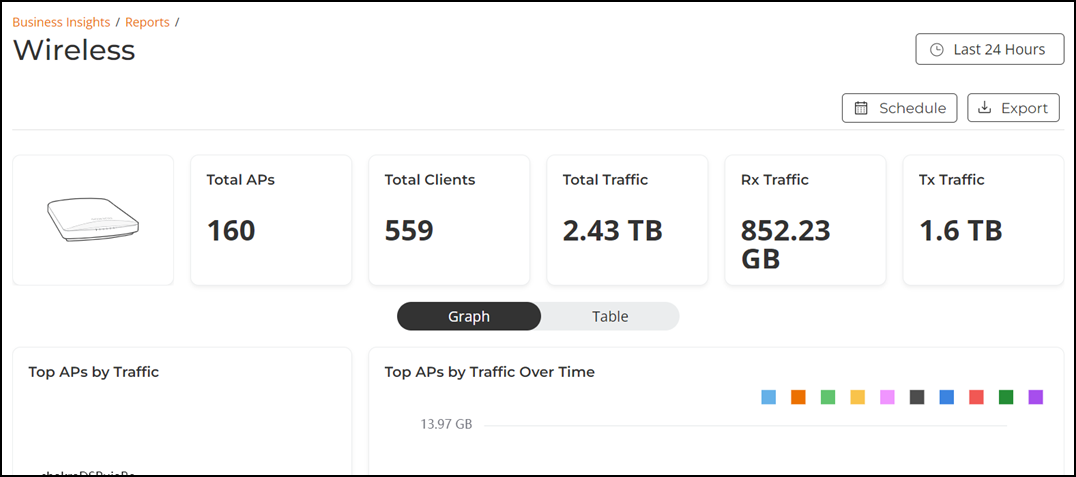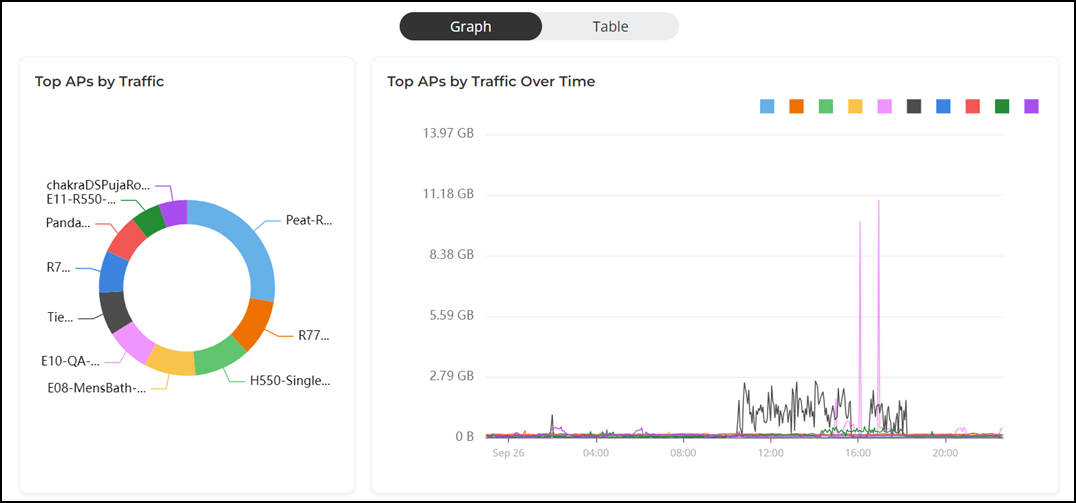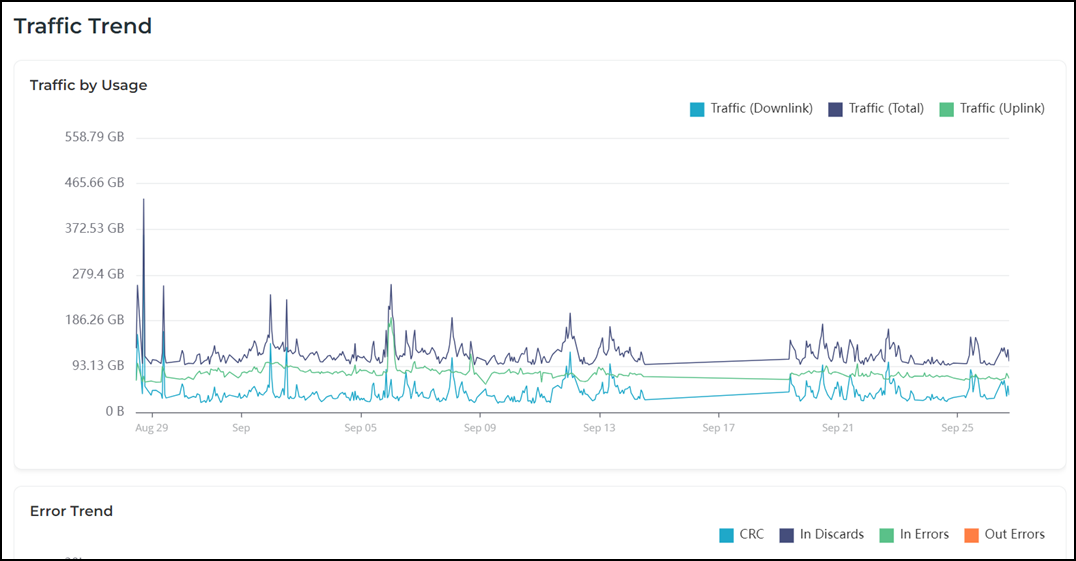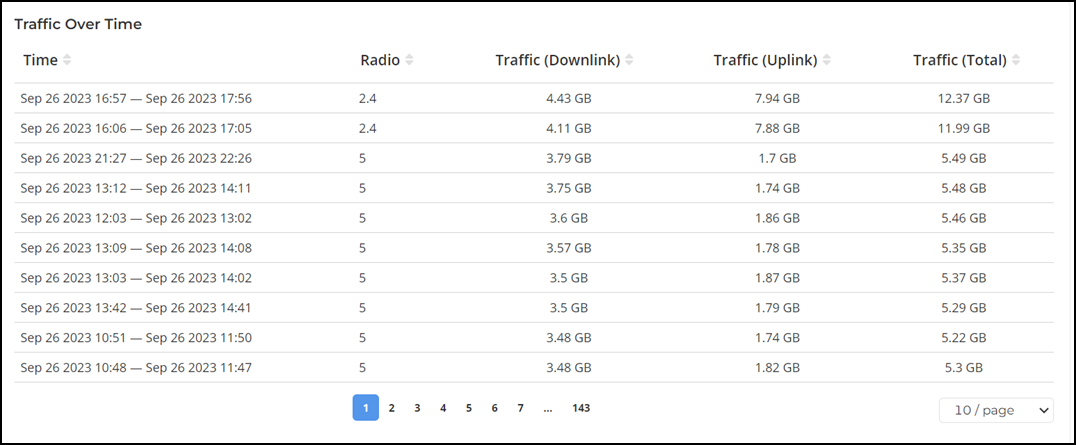Wireless Report
The Wireless Report page provides details of traffic, clients, and trends by APs, SSIDs, radio, or clients over time.
From the navigation bar, select . Alternative path, . The Wireless Report page is displayed.

The Wireless Report page has the following components:
- Overview tile
- Top APs by Traffic tile
- Top APs by Client Count tile
- Network Usage Overview tile
- Traffic Trend tile
- Traffic Over Time Table
The top right corner of the Wireless Report pages display options to share and export reports in PDF and PNG formats. You can also share them with recipients over e-mails on-demand or periodically by configuring a schedule (daily, weekly and monthly). To download or create a schedule, refer to Navigating the RUCKUS One Portal.
The network node and Date and Time filters are displayed in the upper-right corner of the Content panel. These options control the elements displayed within the Content Panel. To modify these options, refer to Navigating the RUCKUS One Portal.
Overview Tile
The Overview tile provides a general overview of the entire network. It displays the count of total APs, total clients, total traffic, total inbound traffic (Rx), and total outbound traffic (Tx) for the selected time period in the Date and Time filter.

Top APs by Traffic Tile
The Top APs by Traffic tile contains two panes Top APs by Traffic and Top APs by Traffic Over Time.
The Top APs by Traffic pane displays a donut chart. The donut chart display the top 10 APs with highest traffic volume in your network for the selected time period in the Date and Time filter. Pausing the pointer over the chart displays an information box with the details of the selected AP.
The Top APs by Traffic Over Time pane displays a graph. The graph display the top 10 APs with highest traffic volume in your network for the selected time period in the Date and Time filter. Pausing the pointer over the graph displays an information box with the details of the selected AP at that time and date. Click any of the colored squares to hide the selected AP in the graph. The information icon that is hidden is displayed in gray.

To view all the APs, click Table icon. The table is displayed with the AP name, MAC, internal IP, downlink traffic, uplink traffic, and total traffic information for the selected time period in the Date and Time filter. In the table, you can select the number of APs displayed in the tile from the drop down at the bottom of the tile. The range is from 10 switches per tile to 200 switches per tile.

Top APs by Client Count Tile
The Top APs by Client Count tile contains two panes Top APs by Client Count and Top APs by Client Count Over Time.
The Top APs by Client Count pane displays a donut chart. The donut chart display the top 10 APs with the most clients on the network for the selected time period in the Date and Time filter. Pausing the pointer over the chart displays an information box with the details of the selected AP.
The Top APs by Client Count Over Time pane displays a graph. The graph display the top 10 APs with the most clients on the network for the selected time period in the Date and Time filter. Pausing the pointer over the graph displays an information box with the details of the selected AP at that time and date. Click any of the colored squares to hide the selected wired switch in the graph. The information icon that is hidden is displayed in gray.

To view all the APs, click Table icon. The table is displayed with the AP name, MAC, internal IP, unique client MAC count, downlink user traffic, uplink user traffic, and total user traffic for the selected time period in the Date and Time filter. In the table, you can select the number of APs displayed in the tile from the drop down at the bottom of the tile. The range is from 10 APs per tile to 200 APs per tile.

Network Usage Overview Tile
- SSIDs
- OS
The SSIDs tile facilitates analysis of the network usage across different SSIDs. Each bubble represents an SSID, with the X-axis showing the total amount of user traffic for each SSID and the Y-axis showing the number of unique client devices (MAC addresses) connected to each SSID. The size of each bubble typically corresponds to the number of Access Points (AP Count) associated with that SSID. Larger bubbles indicate SSIDs supported by more access points.


Traffic Trend Tile
- Traffic by Usage tile
- Traffic by Radio tile


Traffic Over Time Table
The Traffic Over Time table displays the 2.4 GHz, 5 GHz, and 6(5) GHz radio traffic between time periods. This data is displayed only for the selected time period in the Date and Time filter. The table is displayed with the time, radio, downlink traffic, uplink traffic, and total traffic. You can select the number of time periods displayed in the table from the drop down at the bottom of the table. The range is from 10 time periods per table to 200 time periods per table.
